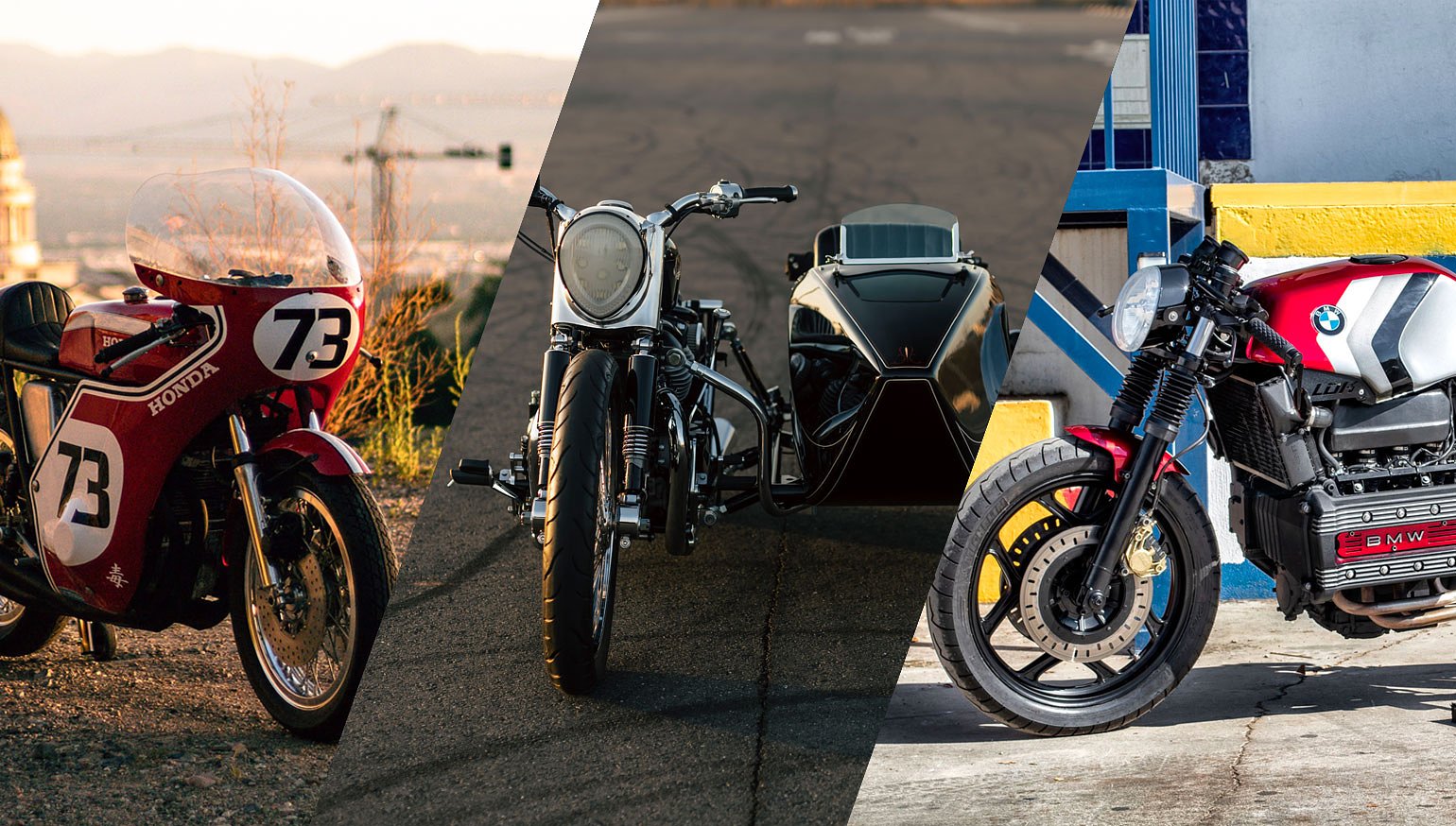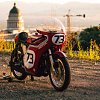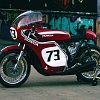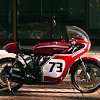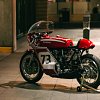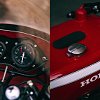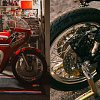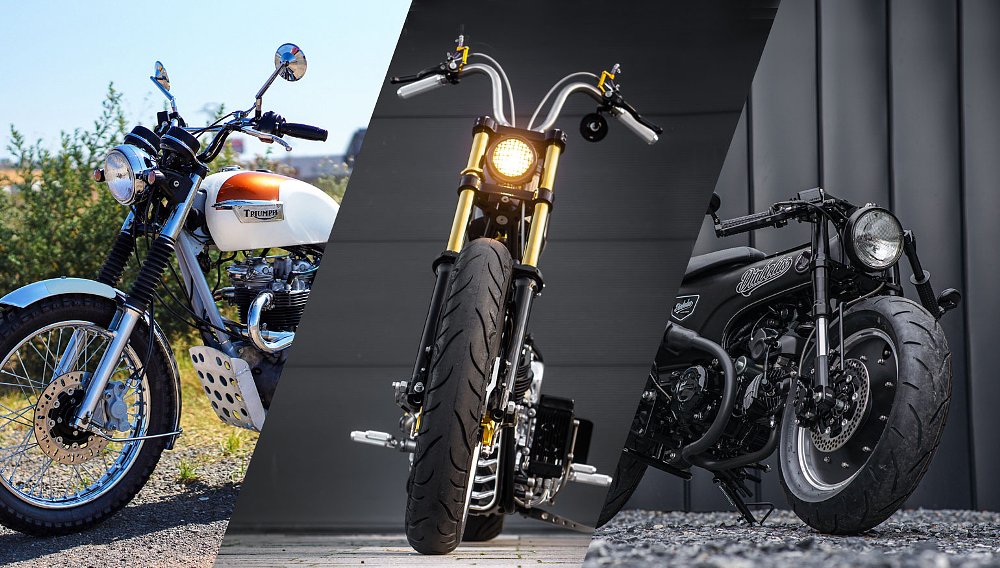In this edition of the custom roundup, we welcome the new year with three very different custom approaches. The first is a purpose-built vintage racer that's an homage to one of Honda's all-time greats. Next is a BMW café racer based on an unlikely donor, and lastly, a brand-new Royal Enfield that's been completely transformed and comes complete with its very own sidecar.

Dalton Devore's Honda CR750 race replica
Some have labeled Honda's 1969 CB750 "the greatest motorcycle ever made," and it's certainly among the most significant. The CB750 popularized the inline-four engine that became the dominant sport bike engine configuration for decades.
After its release, Honda set out to prove the CB750's performance capabilities to the world by producing a limited number of race bikes. Legendary racer Dick Mann piloted one such bike to victory at the 1970 Daytona 200, an event that contributed to the success of the CB750 in the U.S. market and quite possibly the world.

Honda created the CR750, a kitted street bike meant to look like Mann's CB750 racer, and this faithfully recreated Honda CR750 racer is the work of Dalton Devore (Instagram). Built to compete in AHRMA historic racing events, it's been a dream project of the Utah native.
"The biggest challenge was sourcing RSC parts, as they are rarer than hen's teeth and are often extremely expensive," Dalton says. As a result, his number 73 CR750 replica took some five years to complete.
Starting with a 1973 CB750K, Dalton has extensively modified the Honda to achieve both the look and performance he was chasing. Starting with the engine, the 736 cc block has been replaced with a JMR 1,000 cc block sporting 73 mm forged pistons. The stage-four head is another JMR part and the intakes have been modified to maximise performance. Inside the cases, there's a balanced crank by Cycle X, Carrillo connecting rods, Kibblewhite cylinder studs, and a spattering of OEM RSC parts.

RSC (Racing Service Center) was the Honda factory team's parts supplier before the formation of their Works Racing motorsport division. Dalton's bike wears an original RSC "970" racing transmission with Daytona ratios, an RSC magneto, and an RSC magnesium cover. Beyond the engine, you'll find more RSC parts in the form of a clutch lever assembly, front master cylinder, front sprocket, RSC Honda tach, and an iconic, blacked-out four-into-four Honda racing exhaust system. Nestled alongside the RSD tach is a Smiths oil pressure gauge and both are housed in a dash that's reminiscent of the original race bike.

For the bodywork, Dalton sourced a CR750 replica kit complete with the full fairing, tiny rear cowl, and long fuel tank. In keeping with the theme, there's also a handmade alloy replica of the CR750 oil tank from a UK supplier. Sporting period-correct Honda decals, white and black pinstripes, and ruby-red paintwork, this bike is a dead ringer for the original CR750s, so it undoubtedly turns more than a few heads when it's out on the track.

On top of everything already mentioned, Dalton added a few mods of his own to step up this bike's performance. The wheels are Excel CR750 spec-shouldered alloy rims wrapped in purposeful Dunlop K164 rubber. The twin front brakes are complemented by a later model CB750 F2 rear disc mounted via a CB350 rear hub. The suspension is stock at the front but tuned to suit Dalton's weight, while in the rear he's added Koni CR750 replica shocks. Finally, to shed as much weight as possible, he's used titanium engine mounts and hardware throughout.
As for the Honda's performance, Dalton says it's nothing short of amazing on the track. The bike is still being dialed in, but with some further suspension adjustments, a steering damper, and a set of Yoshimura carbs, it'll have serious podium potential in the upcoming 2024 AHRMA roadracing series.

Lord Drake Kustoms BMW K100
Despite a rather unsavory nickname of the "Flying Brick," retired models from the BMW K series have become popular donors amongst custom enthusiasts. This custom build has seen the portly sport-tourer transformed into a naked café racer and it's the work of Spanish builder Francisco Alí Manén and his team at Lord Drake Kustoms (Instagram).
Lord Drake Kustoms is best known for its work on Harley-Davidsons, but they're always eager to turn their hand to something new. So when the owner of this 1984 K100 rolled into their workshop, they jumped at the opportunity to turn it into something special. As a bonus, the bike was in excellent mechanical condition, meaning they could focus their efforts on the most exciting part of every build, the styling.

The goal was to give the K100 a sportier, race-bred demeanor. But to do this confidently, they had to ensure the bike handled right. Work began with a complete rebuild of the front end to deal with changes to the weight distribution. As the fork went back on, clip-on bars wearing new switch gear, aftermarket grips, and bar-end mirrors were slid onto the stanchions. Balancing things out in the rear is a WP piggy-back monoshock.

Next came some new bodywork in the form of a custom-made rear cowl sporting a diamond-stitched saddle. To fit it to the bike, they cut away the rear of the frame and fit a custom-made subframe. The new structure leaves the rear end open for visual lightness and has turn signals cleverly integrated into its design. To achieve a classic café racer bone line, the original fuel tank has been modified to reposition it on the frame.

Further adding to this brick's slick facade is a collection of laser-cut brackets and covers that spruce up unsightly areas of the engine. The front end has been cleaned up with the fitment of twin, classically styled gauges, and the headlight assembly from a Harley-Davidson V-Rod. Out back, the tail is looking tidy thanks to a hugger-style license plate assembly. And finally, to add a bit of bark to the 987 cc brick, there's a Supertrapp muffler hanging off the four-into-one headers.
To complete this K100's striking new look, Lord Drake Kustoms has finished it in a red-and-silver paint scheme with graphics inspired by BMW M series livery. It may not be a motorcycle I'd choose for my next café racer conversion, but there's no denying this flying brick certainly looks the part.

Cherry's Company Royal Enfield Super Meteor 650
During my recent visit to India for the Royal Enfield Motoverse festival, I learned that the manufacturer clearly has a vested interest in the custom scene. With the unveiling of its latest modern retro model, the Super Meteor 650, Royal Enfield has proven the point by commissioning workshops around the world to customize it. One such project took place in Japan with the intention of unveiling the bike at the 2023 Mooneyes Yokohama Hot Rod Show (HRCS). The builder Royal Enfield tasked with the job was multi-HRCS award-winning builder Kaichiroh Kurosu, otherwise known as Cherry’s Company (Instagram).
For this project, Royal Enfield gave Kurosu-san exactly the kind of brief every builder dreams of, complete freedom, and he took full advantage of it.

"I have always wanted to build a sidecar. But I never had a chance to do it until now," he says. "I was free to do whatever I wanted, except for the rule of keeping the concept of a cruiser. So, I thought I could build a sidecar. Since a sidecar is also a great cruiser!"
Kurosu-san had dabbled with sidecars while working at a Harley-Davidson dealership some 23 years ago, but he'd never attempted a ground-up sidecar build. So he coined the project "Challenger" due to the amount of unforeseen obstacles he knew he'd face, and by all accounts, the bike lived up to its name.

The concept was to take styling cues from a Cherry's Company build from 2013, a H-D Shovelhead chopper named Left Bond. That bike earned him an HRCS Best in Show trophy and had been one of the factors that led to Royal Enfield selecting him for this project.
After stripping the bike, Kurosu-san experimented with ride heights. During this process, he realized the chassis and swingarm had very appealing lines. So rather than building a whole new chassis, he modified the existing one. The work included bracing the frame around the neck tube to increase its strength, fabricating a new main tube, and making minor modifications to the subframe.

For the suspension, Kurosu-san took cues from an Earles Fork, a 1950s design that originated in the UK and used a leading link configuration. The new setup is entirely bespoke and designed to both withstand the rigors of carrying a sidecar and to tie in well with the proportions of the Super Meteor. Although this all sounds pretty straightforward, the fork had to be built multiple times to get it to function how he wanted. In the rear, a much easier route was taken with the fitment of modified Sportster shocks.
"Sidecars require a shorter trail than two-wheeled motorcycles," Kurosu-san explains. "Therefore, the front axle was made into an eccentric adjuster so that the amount of trail can be easily changed according to the presence or absence of the sidecar."

Building the sidecar itself also took some trial and error. Kurosu-san paid special attention to scale to get the right balance of style and function. Once again, this took multiple attempts, but the result speaks for itself.
"I designed the sidecar body to be around 1,700 mm (about 67 inches) in length. Of course, there had to be enough space for an adult person to ride in the sidecar," he says. "I was imagining a wooden Dutch shoe and vintage sidecars I'd seen. First, I made a large block of Styrofoam and then shaped it by hand. Then, I pasted fiberglass onto the finished prototype."

The sidecar features a custom suspension system, too. To create it, Kurosu-san repurposed the leaf spring from a Japanese K-truck, which he mated with a damped motorcycle spring. Adding to the complexity of the whole design, the sidecar and all of its fixings can be removed, allowing the bike to be ridden on its own. Those with a keen eye will note the lack of a front brake, which was a stylistic decision. To compensate for it, there's a bespoke twin disc brake system in the rear.
Beyond the engineering challenges, Kurosu-san set himself some high goals regarding the bike's finished appearance. The motorcycle's bodywork has been hand-shaped from aluminum and a large portion of it has been polished to a mirror finish. The spoked wheels were all custom-made to give the bike the look of a vintage car. The teardrop headlight was also inspired by vintage cars and it features a custom-made lens cast from resin. To complete the look, the paintwork is a mix of glossy black, gold leaf pinstriping, and hand-laid emblems.

The finished result is impressive, to say the least, and the judges agreed at the 2023 Mooneyes HRCS. The Cherry's Company Challenger took home three trophies, including the award for Best Detail Work. I'm guessing that Royal Enfield couldn't have been happier with that result.


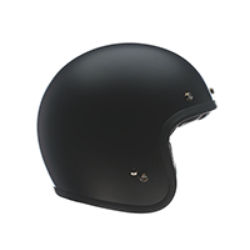

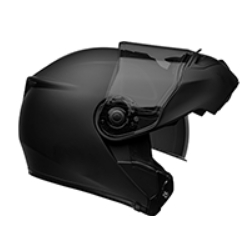

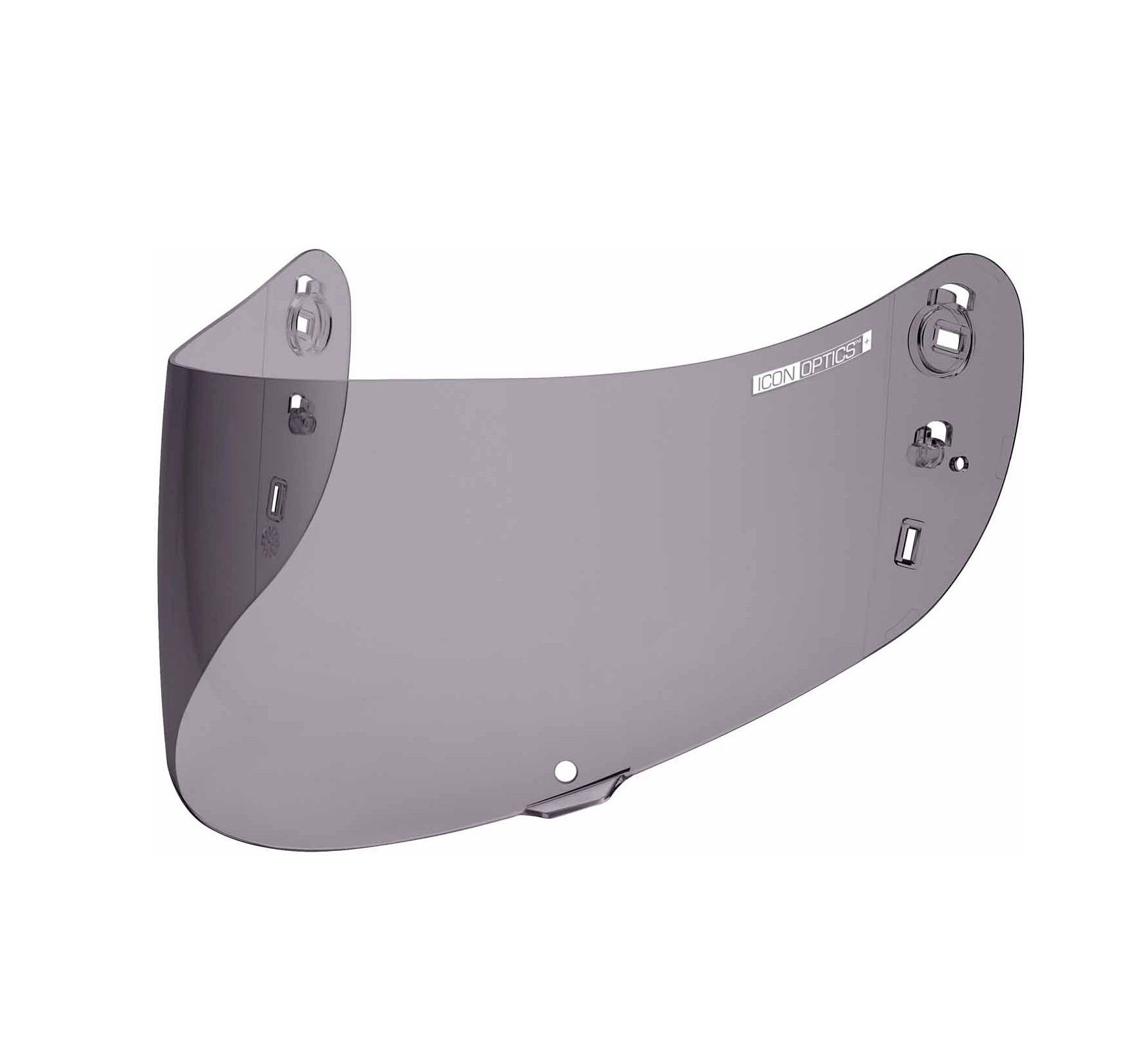
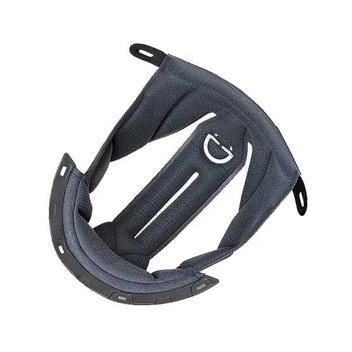
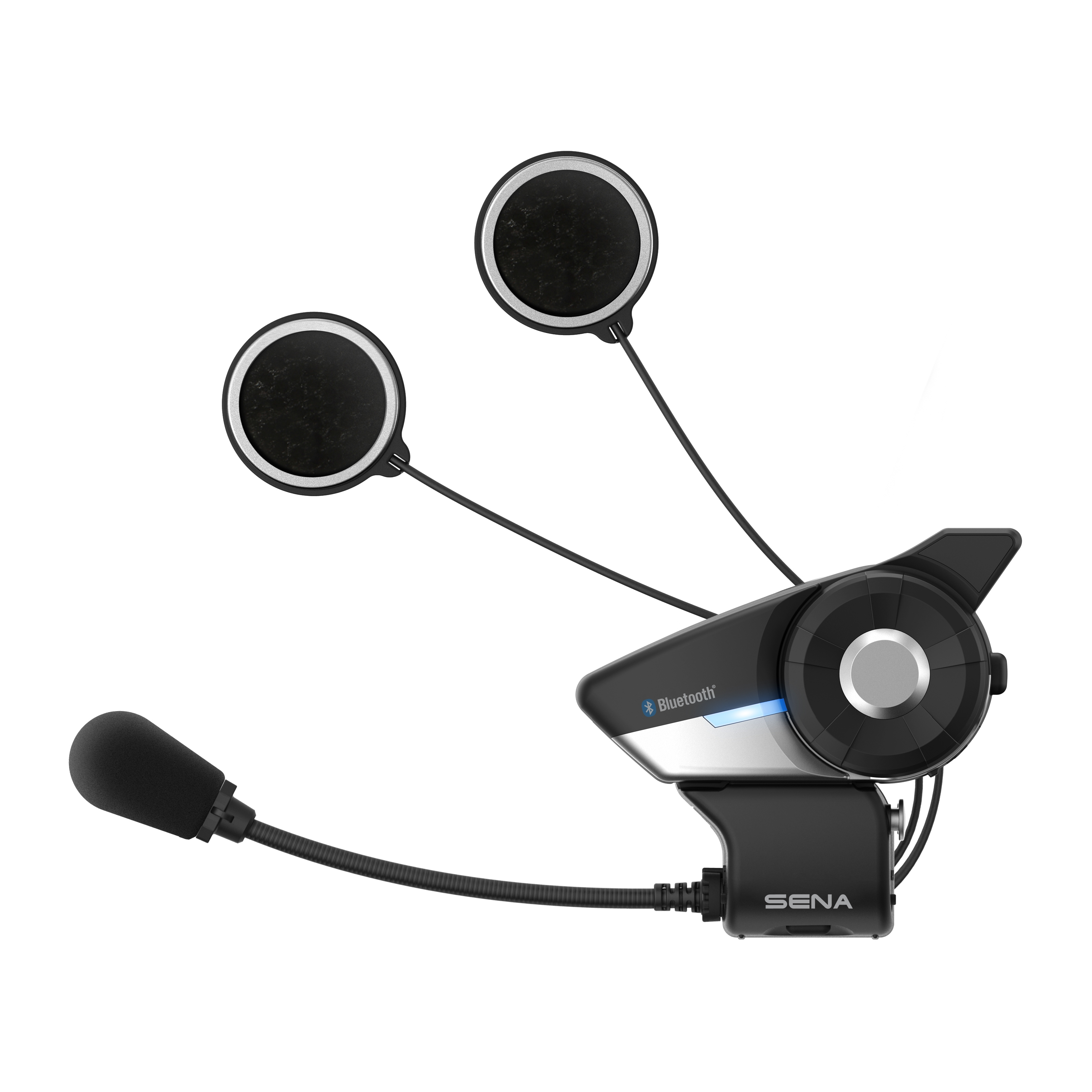
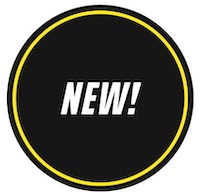

 Membership
Membership

